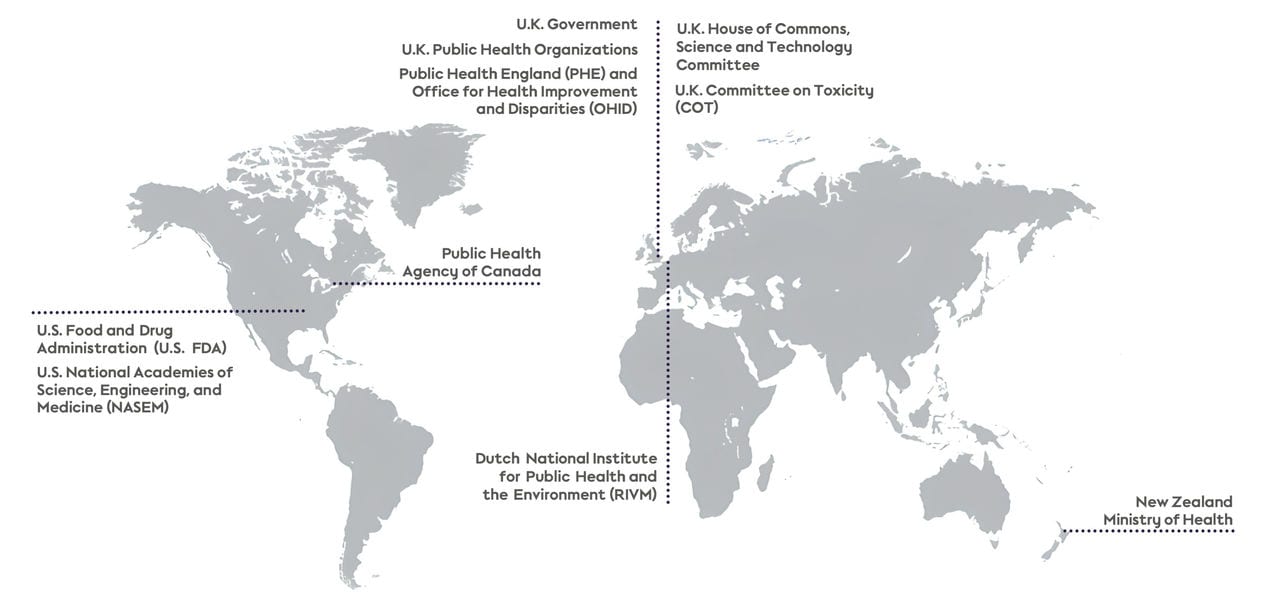Government health authorities’ view on e-vapor products
U.K. Government
The U.K. government released in 2017 a five-year Tobacco Control Plan for England emphasizing the role that e-cigarettes could play in reducing the harm caused by smoking:
“ … the evidence is increasingly clear that e-cigarettes are significantly less harmful to health than smoking tobacco.” The document highlighted the government’s stated commitment to evidence-based policymaking by defining the following aims: “Help people to quit smoking by permitting innovative technologies that minimise the risk of harm.” and “Maximise the availability of safer alternatives to smoking.”
Following the end of this plan, the U.K. government has set an ambitious goal of being smoke-free by 2030 by reducing smoking rates to 5% or less. It is actively encouraging adult smokers to consider using e-cigarettes through national initiatives such as the Stoptober campaign, a month-long national stop smoking challenge, and a ‘swap to stop’ scheme whereby one million smokers are encouraged to swap cigarettes for e-cigarettes in a world-first national scheme.
U.K. Public Health Organizations
In 2016, Public Health England and 12 other public health organizations (including Action on Smoking and Health, Association of Directors of Public Health, British Lung Foundation, Cancer Research U.K., Faculty of Public Health, Fresh North East, Healthier Futures, Public Health Action, Royal College of Physicians, Royal Society for Public Health, U.K. Centre for Tobacco and Alcohol Studies, and U.K. Health Forum) issued a joint statement on e-cigarettes, mentioning that “We all agree that e-cigarettes are significantly less harmful than smoking. One in two lifelong smokers dies from their addiction. All the evidence suggests that the health risks posed by e-cigarettes are relatively small by comparison but we must continue to study the long-term effects.”
Public Health England (PHE) and Office for Health Improvement and Disparities (OHID)
Public Health England (PHE) was a governmental agency aimed at protecting and improving health while reducing health inequalities. PHE was disbanded in 2021 and its functions transferred to various agencies, with the tobacco-related functions moved to the Office for Health Improvement and Disparities (OHID).
Since 2014, PHE has conducted several scientific reviews on e-cigarettes, updating and expanding on the evidence of the implications of e-cigarettes for public health. Key conclusions across the PHE reports maintain that e-cigarettes are a less harmful alternative and can positively impact public health.
The 2022 update conducted by OHID was consistent with the findings of previous updates as well as the policy position of supporting smokers in switching to e-cigarettes while preventing nonsmokers from initiation. According to Nicotine vaping in England: 2022 evidence update main findings, the overall conclusions are:
- “In the short and medium term, vaping poses a small fraction of the risks of smoking.
- Vaping is not risk-free, particularly for people who have never smoked.
- Evidence is mostly limited to short and medium term effects and studies assessing longer term vaping (for more than 12 months) are necessary.
- More standardised and consistent methodologies in future studies would improve interpretation of the evidence.”
U.K. House Of Commons, Science and Technology Committee
The Science and Technology Committee of the U.K. House of Commons is charged with the scrutiny of the expenditure, administration, and policy of the Government Office for Science, a semi-autonomous organization based within the Department for Business, Innovation, and Skills. The Committee examines the full scope of science policy and related matters across government. In August 2018, the Science and Technology Committee published a report of its inquiry into e-cigarettes after reviewing over 100 pieces of written evidence, as well as oral evidence from 25 public health and industry experts.
The report draws conclusions based on the evidence presented to the Committee, as well as policy recommendations. The Committee highlights that “The best thing a smoker can do for their health is to quit smoking. However, the evidence is increasingly clear that e-cigarettes are significantly less harmful to health than smoking tobacco.”
U.K. Committee on Toxicity (COT)
The U.K. COT is an independent scientific committee that provides advice to the Food Standards Agency, the Department of Health and Social Care, and other government departments and agencies on matters concerning the toxicity of chemicals. In September 2020, the COT, on the request of the Department of Health and Social Care and Public Health England, assessed the potential risk to human health coming from electronic nicotine delivery systems (ENDS) and electronic non-nicotine delivery systems (ENNDS).
Overall, the COT concluded that the use of e-cigarettes is likely to lead to a reduction in harm to health as the relative risk of adverse health effects from their use would be expected to be substantially lower compared with smoking. Furthermore, the report also stated, “This [risk reduction] is supported by biomonitoring studies which show lower levels of tobacco-related toxicants in E(N)NDS users compared with CC [conventional cigarettes] smokers.” However, it also mentioned that “There is a lack of information regarding effects of long-term exposure to E(N)NDS aerosols. Prospective epidemiological studies would help to address this data gap.”

U.S. National Academies of Science, Engineering, and Medicine (NASEM)
The National Academies of Science, Engineering, and Medicine (NASEM) are private, nonprofit institutions that provide expert, science-based advice on critical issues to inform policies with evidence. The NASEM Committee on the Review of the Health Effects of Electronic Nicotine Delivery Systems published a consensus study report titled “The Public Health Consequences of E-Cigarettes” in 2018 where it conducted a review of scientific evidence that addresses competing views on the public health consequences of e-cigarettes.
The report recognizes the need to explore tobacco harm reduction policies by stating that “Despite these efforts and in spite of successes to reduce initiation and increase cessation, a substantial portion of Americans still become regular smokers. Some of these regular smokers are unwilling to quit, and even among those who want to quit, some have serious difficulty quitting. For these populations who continue to expose themselves and others to harm from combustible tobacco use, it is appropriate to consider strategies that minimize or reduce but not eliminate harm from smoking.”
The report also asserts that encouraging the use of less risky products such as e-cigarettes can only have public health benefits. “ … if e-cigarettes confer lower health risks compared with combustible tobacco cigarettes, encouraging use of this reduced-risk product rather than encouraging abstinence only could have public health benefits.”
U.S. Food and Drug Administration (FDA)
The U.S. FDA is the government agency responsible for the authorization and monitoring of various consumer products. Within the FDA, the Center for Tobacco Products is responsible for regulating the manufacturing, marketing, and distribution of tobacco products.
In 2017, the agency announced a comprehensive plan for tobacco and nicotine products, with the goal of “striking an appropriate balance between regulation and encouraging the development of innovative tobacco products that may be less dangerous than cigarettes.”
In October 2021, the FDA authorized the marketing of the first set of electronic nicotine delivery system (ENDS) products ever through the Premarket Tobacco Product Application (PMTA) pathway. According to the FDA’s press release: “Today’s authorizations are an important step toward ensuring all new tobacco products undergo the FDA’s robust, scientific premarket evaluation. The manufacturer’s data demonstrates its tobacco-flavored products could benefit addicted adult smokers who switch to these products – either completely or with a significant reduction in cigarette consumption – by reducing their exposure to harmful chemicals.”
New Zealand Ministry of Health
In 2011, the New Zealand (NZ) government set itself a target of becoming smoke-free (achieving less than 5% daily smoking prevalence) by 2025. Since then, the government has increasingly focused on strategies to restrict smoked tobacco products through tax and regulatory measures such as plain packaging. However, by 2018, smoking prevalence was not falling as fast as the government hoped, having missed prevalence targets by a significant margin.
In 2020, the Smokefree Environments and Regulated Products (Vaping) Amendment Act 2020 was enacted to regulate smoke-free products, recognizing that these could help reduce smoking faster, mitigate health inequalities (the smoking rate was much higher within NZ’s indigenous Maori community), and get ‘back on track’ for the 2025 smoke-free goal. One of its stated purposes, enshrined in the Law itself, is to “support smokers to switch to significantly less harmful products”.
An official commentary from the NZ Parliament’s Health Select Committee explained: “The bill acknowledges that vaping products and heated tobacco products have lower health risks than smoking, and aims to support smokers to switch to these less harmful products.”
“The bill also recognizes that many smokers need support and advice to successfully move to less harmful alternatives, so the Bill allows for the provision of information and advice for those wishing to switch from smoking to vaping.”
Dutch National Institute for Public Health and the Environment (RIVM)
RIVM is an agency of the Dutch Ministry of Health, Welfare, and Sport. In 2016, it issued a report on Tobacco Harm Reduction and potentially less harmful tobacco products, including e-cigarettes, amongst others.
The summary of the section on e-cigarettes states that: “The available data on the harmfulness of e-cigarettes show that e-cigarettes are a less harmful alternative for conventional cigarettes. It is not yet clear, however, whether e-cigarettes can play a role in smoking cessation and whether using e-cigarettes acts as a gateway to using conventional cigarettes.”
Public Health Agency of Canada
The Public Health Agency of Canada sets it focus on preventing disease and injuries, responding to public health threats, promoting good physical and mental health, and providing information to support informed decision making.
In March 2022, the agency published a discussion paper conducting the first review of the Tobacco and Vaping Products Act (TVPA), which came into force in 2018 “in response to the national public health problem posed by tobacco use.” This paper examined the first three years since the law was implemented “to respond to the increasing availability of vaping products (with and without nicotine) in Canada and to help ensure that Canadians would be appropriately informed about and protected from the risks associated with these products.”
The paper mentions that “while scientific knowledge continues to evolve, there is a general consensus in the scientific community that for people who smoke, switching completely to vaping is less harmful than smoking conventional cigarettes. In that context, potential public health benefits associated with reducing tobacco-related disease and death might be realized if adult tobacco users either quit or switched completely to vaping as a less harmful source of nicotine.”




